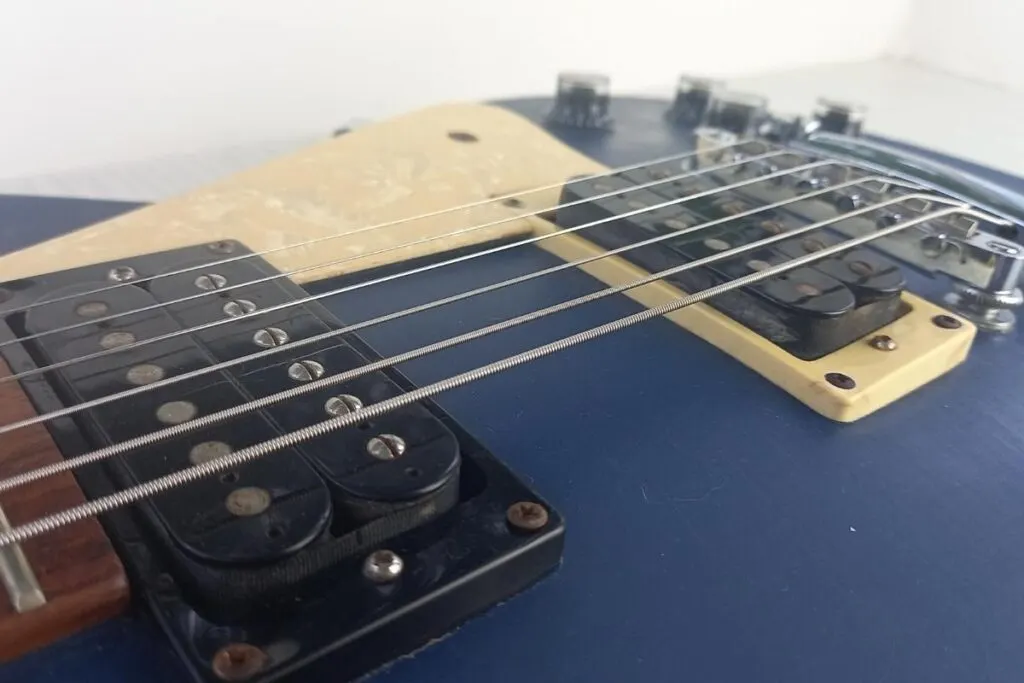We all want to get the best possible tone from our guitars, and to that end, many guitars support coil tapping or coil splitting.
I constantly see people get the differences between the two wrong. So, unfortunately, guitarists are often left confused and without a clear answer. I’ve compared coil tapping and coil splitting to get to the bottom of this once and for all!
Coil splitting involves temporarily disabling one of the coils in a humbucker pickup. It leaves the guitar with a single-coil sound similar to a Stratocaster or Telecaster. Coil tapping changes where the signal is taken from in the pickup’s coil. This lowers the output to give a vintage guitar tone.
The difference between coil splitting and coil tapping may seem almost irrelevant to most people, but there are some key differences and reasons to use one or the other, if your guitar supports it.
What is coil splitting?
Humbuckers have two pickup coils inside. These coils work together to give the humbucker its characteristically full, warm, and hum-free tone. The tone produced by humbuckers is very different from that of a single-coil pickup, which is thinner, and is more likely to pick up background hum.
Coil splitting is where one of the coils of a humbucker pickup is temporarily disabled, leaving only one coil active. This effectively turns the humbucker into a single-coil pickup. The result is a guitar that sounds much more like a twangy Fender Stratocaster or Telecaster than a beefy Gibson Les Paul or SG.

I’ve found that coil-splitting is much more common on Fender guitars, whereas coil-tapping is more common on Gibson’s (but more on that later!).
How does coil splitting work?
Coil splitting works with humbucker pickups that have the coils connected in series (or 4-conductor wiring, as it’s also called). With this type of wiring, manufacturers connect a switch that bypasses one of the coils from the circuit while leaving the other coil active.
You can do this by connecting the south coil’s starting point contact to your output, then connecting all three of the other contacts on the pickup with each other and the ground using a single length of wire.
Anyone with some knowledge of electronics will be able to do it, as long as they are handy with a soldering iron. Still, I always recommend speaking with a professional before undertaking any large jobs like this!
Of course, you can always buy a guitar with coil splitting pre-setup as one of the guitar’s default features. A lot of modern Fender guitars come with coil-splitting functionality off the shelf, like the Player Telecaster HH and the Deluxe Stratocaster HSS.
How to use a guitar with coil splitting
On most modern guitars, coil splitting functionality is set up using push-pull pots on the volume or tone knobs.
With the pots pushed down, your pickups will operate at full power. Your humbuckers will be at total volume, happily bucking away that hum! The coil splitting will activate when you pull the pots out, and your guitar will have a much snappier, single-coil sound.
To bring it back to its humbucker glory, you simply push the knob back in, which reactivates the disabled coil.
Question: Do you have a coil split or coil tapped guitar? Let me know in the comments below!
What is coil tapping?
Coil tapping is similar to coil splitting in its result but not its method. Whereas coil splitting completely disables one coil in a two-coil humbucker pickup, coil tapping does not disable anything but instead takes the output from another point of the pickup which minimizes the pickup’s output.
Unlike coil splitting, coil tapping can be done to both single-coil and humbucker pickups. It gives your guitar more of a bluesy or classic rock tone. You’ll see it most commonly as a feature on modern Gibson guitars, as a way to achieve the vintage sounds of yester-year.
How does coil tapping work?
To clearly understand coil tapping, you need to understand how pickups process sound. I’ve written a detailed guide on how pickups work that explains everything you need to know.
Put simply, pickups contain either one or two coils (single coils and humbuckers, respectively). These coils are made of copper wire that make a signal from your magnetized strings through a process called electromagnetic induction. If this sounds too sciency, I’ve broken it down simply in my other article.
With this in mind, coil tapping involves connecting a wire to the coil that takes the output from about halfway through each pickup coil instead of at the end of the coil. When the coil tapping is disabled, the tone is carried from the pickup in the usual way, but when you enable coil tapping, the wire in the middle kicks in and carries the tone before it can reach the end of the coil. This reduces the amount of sound that’s output.
How to use a guitar with coil tapping
Many popular higher-end guitars include coil tapping as a standard feature, especially Gibson’s more expensive Les Pauls and SG models.
If you have a guitar with coil tapping enabled, you will see that your tone control knobs aren’t regular knobs but rather push-pull pots. When the pots are pushed in, coil tapping will be disabled, but you can pull them out to enable coil tapping and get that more bluesy sound.
Different guitars handle coil tapping differently. You may even find one with knobs or switches specifically to enable and disable the feature. But the most common method involves push-pull pots on either the volume or tone knobs (most commonly on the tone knobs!).
Coil tapping vs coil splitting: Which is better?
This question’s answer isn’t as straightforward as you might think. The one isn’t truly better than the other. In fact, though the results are similar, there is a distinct tonal difference between the two, so you might have to decide which tone you prefer. Ultimately, the answer is up to you, but you should be aware of the pros and cons of coil tapping and splitting.
Coil splitting pros and cons
There are a few advantages to coil splitting, including:
- It gives your humbucker guitar a more Stratocaster or Telecaster-like sound. It gives your guitar more tonal range and possibilities.
- Adapting your guitar is easy to do yourself if you have the right pickups and are not afraid of some light tinkering on your guitar.
- Single-coil pickups are generally more articulate than humbuckers, and coil splitting will give your humbucker the same fast response you will get from a single-coil pickup.
But there are a few disadvantages, too:
- The sound won’t be quite as clear as that of a proper single-coil pickup. Additionally, it can sound very shrill since coil splitting mostly accentuates the treble tones.
- Your output will be reduced. You shouldn’t expect the same volume and output quality that you would have without coil splitting.
- The hum may come back. This will depend on the guitar and the pickups you use, but in most cases, eliminating one of a humbucker’s coils will cause the background noise to return.
Coil tapping pros and cons
Some of the advantages of coil tapping are:
- Like coil splitting, it gives you two distinct tones to play without switching guitars.
- Coil tapping works on humbuckers and single-coil pickups, so you might be able to use the function whichever guitar you have.
- You can get a tremendous bluesy or old-school rock sound from your guitar.
- A lot of modern guitars come with built-in coil tapping, so you may not have to modify your guitar to enable it manually.
However, there are still a handful of disadvantages to coil tapping:
- The sound still isn’t that great. Fans of vintage style pickups are generally unsatisfied with coil tapping, as it imitates the sound if vintage pickups rather than reproducing it
- Coil tapping also leads to reduced output. The volume could drop to roughly 50% of what it would be when you don’t use coil tapping.
- Coil tapping is much more challenging to add to your guitar than coil splitting, if it isn’t pre-configured with the function.
Conclusion
Coil tapping and coil splitting are two similar but very different ways of changing the sound of your guitar’s pickups. Broadly speaking, coil tapping will give your guitar a more vintage, classic tone as it emulates the lower output of classic pickups. Coil splitting, however, will switch your humbucker into a single-coil, giving you a twangy, clear sound.
Like most things, neither one is better than the other; it’s all a matter of personal preference. But both are great ways to add more tonal options to your guitar, letting you craft the sound that works for you!
Related Questions

Conor is a music producer, multi-instrumentalist, and all-round enthusiast from the UK with over 15 years of experience. He’s the founder and sole-content creator for the roundtable audio blog and YouTube channel.
